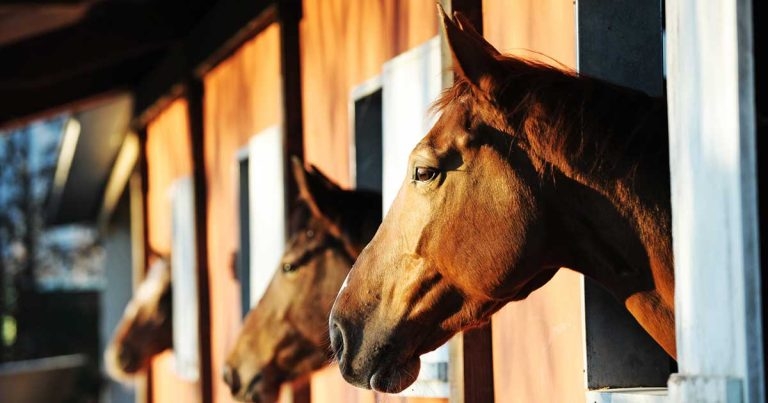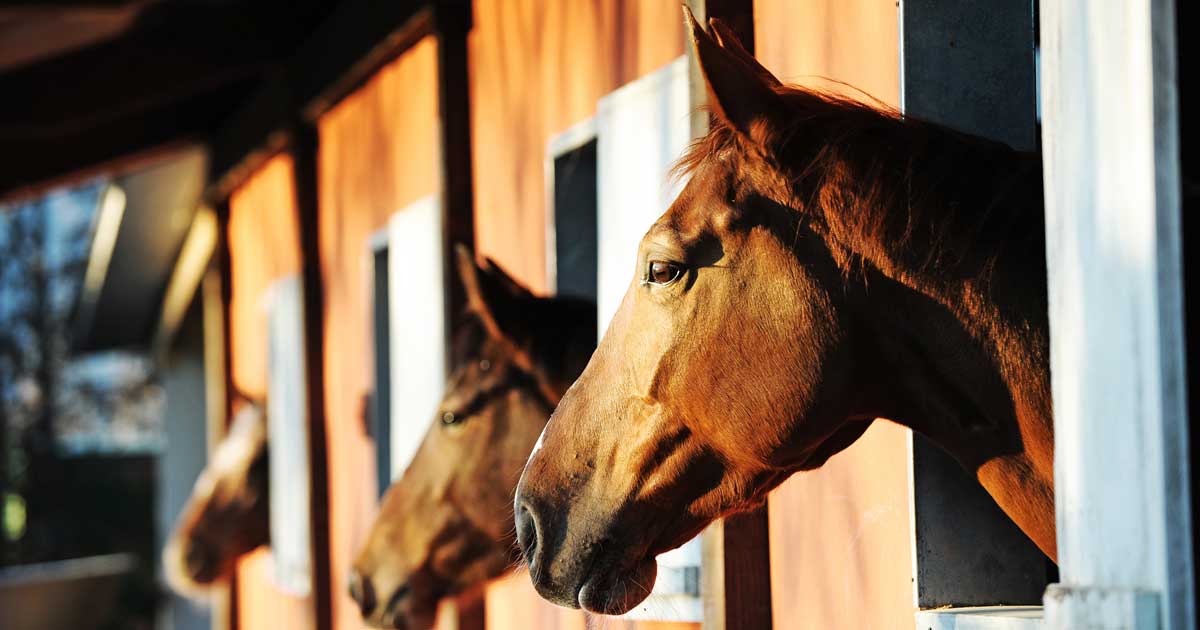4 May 2022
Jamie Prutton outlines common conditions in horses, and how to test for and treat them.

Image: © stokkete / Adobe Stock

Insect bite hypersensitivity (IBH) is a chronic, recurrent seasonal (spring, summer and autumn) dermatitis that is known to affect 5% to 50% of horses dependent on their location, breed and genetics (Schaffartzik et al, 2012).
The prevalence of the disease is based on the geographical and local distribution of midges and, therefore, can be well controlled if the local environment is changed.
The pathological state is an allergic, pruritic dermatitis predominantly caused by immunoglobulin E (IgE) mediated type one hypersensitivity reaction to the antigens present within the saliva of Culicoides species.
Atopic dermatitis (AD) is another common dermatological condition that is again associated with IgE-mediated hypersensitivity to various allergens.
IBH is induced by the introduction of various salivary gland proteins from the Culicoides species, leading to a sensitisation in horses that are predisposed to the disease.
Through a complex immune response, an increased production of IgE occurs, leading to an inflammatory response through the release of histamine, but also non-histamine induced inflammatory responses.
Recent work has shown a significant difference in the transcriptome of the epithelium in horses suffering from IBH compared with those with normal skin.
These changes were associated with interleukin-13 upregulation, changes in metabolism of lipids and hypoxic pathways.
All the changes the research group found suggest a predisposition exists for IBH development due to an impairment of the epithelial barrier (Cvitas et al, 2020), allowing inflammation to occur. This fits with the research that has shown a genetic predisposition to IBH.
In IBH cases, horses are most affected in the summer although disease can also be seen in both spring and autumn.
Horses will show severe pruritus of the mane and tail area, while to a lesser degree some will be affected along the ventral midline and face. Often, clinical signs will start with papules, urticaria, and tufted hair or changes in hair structure. These changes can then progress to self-excoriation due to the severity of the pruritus. Winter normally leads to relief, as the Culicoides are no longer present in the environment.
Patients with AD can be affected year-round depending on the allergen involved, but frequently horses will appear worse in periods of high allergen load (for example, when plants are flowering). Lesions can appear similar to IBH, but can affect any part of the body depending on the allergen involved, and the horses will frequently be pruritic.
Diagnosis of IBH is frequently made on the clinical signs alone as they are frequently pathognomonic for the disease. Intradermal and serological tests have been trialled, but the results for this have been variable with cases of both false positive and negative results occurring due to the use of whole Culicoides for the antigen rather than the saliva proteins themselves (Quinn et al, 1983; van der Meide et al, 2012).
AD conversely requires the use of intradermal skin tests (IDST) to guide the diagnosis, as well as assessment of the environment and the allergens the horse is exposed to (Rendle et al, 2010).
Biopsy in both cases can be informative as it will ensure no other aetiologies lead to the clinical signs and can confirm a high number of eosinophils likely indicative of an allergic response. If biopsies are taken, it is also wise to culture the samples to ensure a secondary infection is not present within the skin, and particular attention should be paid to growth of Staphylococcus aureus for evidence of meticillin resistance.
For both syndromes, treatment and prevention will be lifelong and require intense management on the part of the owner.
A multimodal approach is the most likely to secure comparative success in either case.
When considering IBH, treatment should include the use of topical insect repellents or blankets; medications including topical treatments; steroids and antihistamines; stabling at dawn and dusk; and potentially immunotherapy.
Peeters et al (2014) found that stabling alone resolved clinical signs in 59% of horses, while blankets did so in 49%.
This confirms that to achieve the best success rate, multiple treatment protocols should be used and treatment should not be based on a single method. When formulating a treatment protocol with the owners, it is helpful to consider a three-tier system to ensure all aspects of management are covered. The three tiers should include:
Control of the pruritic response can be done with either systemic or topical medication. Systemic steroids can be used with oral prednisolone (1mg/kg by mouth every 24 hours) being the treatment of choice initially.
If a limited response is seen, dexamethasone (0.1mg/kg IM every 24 hours) can be trialled. Antihistamines are of limited use in most cases, but can be used as an adjunctive therapy.
Topical treatments, including spray
hydrocortisone or cream hydrocortisone/triamcinolone, has its place but will only be efficacious when limited hair is present. It should be highlighted that steroids can be used palliatively to break the itch-scratch cycle, but they will not be curative while exposure to the midges is ongoing. Topical treatment can also include antimicrobial shampoo if a secondary infection has occurred following self-excoriation. Systemic antibiotics might be warranted in the most severe of cases, but a sensible antibiotic stewardship approach should be taken to their use.
The last tier, prevention of further exposure, is frequently the most challenging and should include multiple different techniques. These can include:
Turnout must be addressed, with proximity to hedgerows or static water increasing the frequency of clinical signs due to the increased burden of midges. Therefore, changing the habitat is essential.
Chemical repellents or insecticides could be effective in reducing the biting rate, or even reducing the population size in an environment. Baker et al (2015) found pyrethroid-based insecticides, which are available in the UK, caused 100% mortality in exposed Culicoides, so the application of these products to rugs may be very beneficial in controlling the population.
Immunotherapy has little effect on cases of IBH due to the use of whole Culicoides antigen rather than proteins directly from the saliva of the Culicoides. Various rugs are available on the market that will reduce the exposure of the horse to midges and will dramatically reduce the incidence of disease. They are a pivotal, if frustrating, part of the treatment protocol.
Following diagnosis of AD via an intradermal skin test, it is possible to use immunotherapy to reduce the clinical signs and hopefully resolve the pruritus. Stepnik et al (2012) evaluated 54 cases of AD treated with immunotherapy, and showed that 84% of cases had a reduction in clinical signs and 59% needed no further treatment beyond the immunotherapy.
Limited reactions to the immunotherapy were seen, although the author has experienced one horse having a severe pruritic episode following administration that required hospitalisation; therefore, owners should be aware of this risk. Alongside immunotherapy, cases will require removal of allergens, where appropriate, and intermittent use of steroids or antihistamines, as described for IBH.
Sometimes, moving from the current stabling/field can reduce the rate of occurrence.
Some clinical trials have been looking at therapeutic vaccinations to control the clinical signs of IBH.
At a cellular level, the main infiltrates into lesions are eosinophils caused by the underlying allergic response. Interleukin-5 (IL-5) is the master regulator of eosinophils and, therefore, it was postulated that by using a vaccine consisting of equine IL-5 bound to a virus-like particle, a reduction in clinical signs by reducing hypereosinophilia would occur.
The group found that those horses that were vaccinated had a clinical improvement in disease scoring (as per the study) of 47% and 21% of patients reaching 50% and 75% improvement, while the placebo group only had 13% reaching 50% improvement, and none reaching 75% improvement (Fettelschoss-Gabriel et al, 2018).
A further study by the same group looked at the use of interleukin-31, which is associated with allergic non-histaminic pruritus, and again found a good improvement in the clinical scores of these horses (Olomski et al, 2020); although, the exact figures were difficult to understand in the paper.
Although not curative vaccinations, work such as this could lead to significant adjunctive therapies being available to the equine clinician.
Cox et al (2020) reviewed a herbal remedy that was stated by the manufacturers to stabilise mast cells and, therefore, reduce the release of histamine and, thus, reduce the subsequent pruritus. The study was funded by the company, but was a double blinded randomised crossover study, which should reduce the risk of bias. This study of 20 horses showed a significant improvement in clinical signs compared with the control group and could provide evidence that other types of treatment are available.
Currently, the product is not in the UK, although the author did not research if it could be shipped to the UK.
As mentioned in the diagnostics, intradermal skin testing is possible. The aim of IDST is to find a diagnosis, but also to hopefully create an immunotherapy. In the author’s experience, immunotherapy for sweet itch has a limited affect, and Ginel at al (2014) reviewed the use of allergen-specific inmmunotherapy as a treatment of IBH.
The study was relatively small, with 10 horses in the treatment and 10 in the control group, but the therapy was blinded to both the owner and the clinician.
Frustratingly, no change in clinical symptoms was seen between either the control or the treatment group, which fits with anecdotal evidence that immunotherapy and IDST is relatively ineffective in IBH cases.
This is likely due to the relatively crude makeup of the allergens, given that the sensitivity is to specific salivary antigens rather than the whole Culicoides midge. The Insol vaccine is often discussed as a treatment for IBH, but the one study that is available (Gehlen et al, 2016) showed no clinical improvement occurred in horses treated with Insol compared to with a placebo. This study encompassed a total of 52 horses across 2 years.
The authors state a trend to a lower score (fewer clinical symptoms) in the treated group was seen, but at no point did this reach statistical significance. Therefore, no evidence that this is currently an appropriate therapy exists.
This more recent research confirms the frustrating nature of the disease and that no one clear treatment is available, but hopefully various groups are working to new treatment modalities.
It is clear to see that the management and treatment of IBH and AD is, and will continue to be, challenging. This is mostly due to the limited effect of each treatment, the individualised care and advice that is required for each case, as well as the intense nature of care that the owners must provide.
Often, client compliance can be poor due to the intensive nature of the care and, therefore, ongoing veterinary support will be required for those cases.